By John Markwell | Contributing Editor
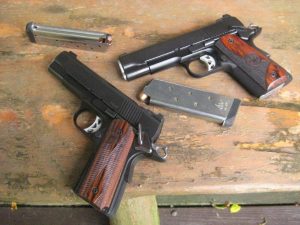
The two Dan Wesson CCOs tested; 9mm on the left with double diamond stocks; 45ACP on the right.
These days, when it seems that many gunmakers are cheapening their products in a race to the bottom of the market, it is refreshing to see a company striving to give the customer a truly quality product at a price that seems almost too good to be true.
That has been our experience with Dan Wesson’s 1911 pistols. Here’s the long version of the story and a review of two Dan Wesson 1911s.
We have an old friend who is extremely well respected (and connected) within the industry. Not long ago, he had the well-known owner of one of the big 3 semi-custom 1911 shops bring him a Dan Wesson 1911 pistol to examine with the statement “tell me how they do this for around $1,000?”
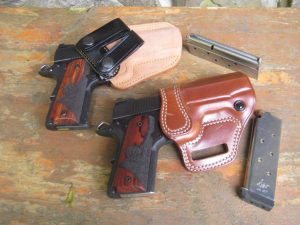
Sheathed in leather From Galco, both the CCOs were light on the hip; Top is the Royal Guard in horsehide bottom is the Avenger in cowhide.
His response, after looking over the gun was “I don’t know. But for a grand or so it’s a bargain.”
Based on our friend’s input, we decided to purchase a new Dan Wesson 1911 Vigil CCO in 9mm to see for ourselves what all the fuss was about. We have a “weakness” for CCO configured 1911s; that being Commander length slides on Officers/Compact sized alloy frames. We have some experience with these handy little guns as built by Wilson Combat, Guncrafter Industries, and Colt and we thought it would be interesting to see how the Dan Wesson Vigil CCO compared to them.
Gun Broker provided the means to acquire our DW Vigil CCO. We won an auction on a NIB gun for $1,049 shipped to our door (we have an FFL). The pistol arrived, in good order and as described, in a compartmented plastic carrying case with manual, lock, a bushing wrench and two magazines. For comparison, we arranged at the NRA show to get a second Vigil CCO on loan from Dan Wesson folks; this one, other than being chambered for the .45 ACP cartridge, is identical to the one we purchased.
To the unenlightened, these Vigil CCO pistols would seem to be just another plain Jane 1911 variant; entry level guns without a lot of bells and whistles. Like other Dan Wesson 1911s however, there’s a lot more to these reasonably priced pistols than first impressions would indicate.
The Vigil CCO’s frames are forged aluminum and hard anodized in black. The front straps are machine checkered 25LPI and the root of the trigger guards are high cut. At the rear of each frame is a well fitted steel beavertail grip safety and an aluminum, slightly round-butted, mainspring housing that is checkered 25LPI. The serrated slide stops are pretty standard in configuration as are the not overly large single-side speed safeties. The hammers are the now ubiquitous large loop Commander style first popularized by, we believe, Steve Nastoff in the late 1970’s. The triggers are aluminum with three triangular lightening cuts and, lastly, the magazine releases are slightly extended and finely checkered. The frames are set off by the attractive and well textured Cocobolo grips with the DW insignia.
Atop the aluminum frames of the DW CCO sits the stainless steel slide, which has the DUTY treatment finish that is basically Melonite; it’s tough, nice looking and highly wear resistant. The top of the slide is matte finished like most entry level guns, while the lowered and flared ejection port is nicely done as are the NM style cocking serrations at the slide’s rear. The sights, both front and rear, are mounted in dovetail cuts; the front sights are AmeriGlo H3 18 night sights while the rear are similar to a Heinie with a sharp front ledge allowing for one-handed slide manipulation.
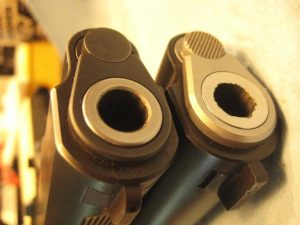
This muzzle view of the two CCOs shows the careful carry beveling common to both pistols.
Both the 9mm and .45 ACP pistols are equipped with stainless match grade ramped barrels which aid in reliable feeding as well as preventing feed ramp wear. The barrels and their respective bushings are well fitted with the muzzles flush with the bushing and nicely crowned.
Two of the most significant advantages of the CCO configured pistols are that, unlike 1911s with shorter-than-Commander slides, CCOs retain the original John Browning designed recoil spring system for the best in reliability and the longer sight radius of the Commander slide makes the CCOs much easier for most folks to shoot well than guns with short slides/barrels.. CCOs blend the best of both the Officers and Commander models; easier accurate shooting, reliability and the reduced butt length to aid in concealment.
However, what really sets the DW Vigil CCOs (and other DW 1911s as well) apart from many Model 1911 pistols in the market place is the little things that add big value to the guns. The first tip on the quality of the DW build process came upon disassembly of the 9mm CCO when it arrived a few months ago. Few “manufacturers” have any reason to serialize the components of the pistols they assemble as most are just put together from parts bins. As most today know, few low to mid-price range pistols involve little if any fitting of parts.
We were surprised to see the pistol’s serial number stamped not only on the frame but also the slide, mainspring housing, and the last four digits were hand etched on the back of the precisely fitted beavertail grip safety. Couple this effort to keep major fitted parts together with the obvious overall excellent finish of all the fire control parts it was obvious there was more than due consideration given to quality in the building and assembly of the 9mm Vigil CCO. And then there are the little things like the carry-beveling of the frame and slide edges; same for the bushing and even the outer and interior edges of the looped hammer. The DW folks even knocked off the sharp edges at the bottom of the front strap/ front of the mag well recess where the checkering on most 1911s seems to always be left sharp enough to shred skin. And then there is the trigger which for a carry gun is just perfect breaking cleanly and consistent 4lb 8oz as tested with our Lyman trigger pull gauge. The 9mm CCO had just the right amount of take up and so little over travel as to be unnoticeable. Breaking as crisply as it does the trigger pull seems much lighter than it is. The 45ACP CCO’s trigger pull weighed in at 4lb 4oz by the way.
Ballistics:
Ammunition Velocity/fps Extreme spread
.45 ACP
Win. 230gr. FMJ 798 27
FED 230gr. Hydra-Shok 866 36
Hornady Critical Duty 220-gr. Flexlock +P 950 24
9mm
Speer LE 147-gr. G2 925 68
FED 147-gr. TMJ 934 23
FED 115-gr. FMJ 1140 34
Hornady Critical Duty 135-gr. Flexlock/service 1043 20
So, by now readers are wondering how do these guns shoot? The 9mm has digested 1,500+ rounds to date and the .45 ACP close to the 500 recommended for break-in. The 9mm has experienced three malfunctions; two failures to fully chamber reloads with fat case heads and one failure to feed of a Federal 124gr. Hydra-Shok round. Out of 1500 rounds fired that aint too bad, as they say. The 45ACP Vigil CCO had two failures to feed with GI 230 gr. ball ammo on its’ first outing: one from each magazine and each was the first round up; go figure. Other than the above, both pistols have been flawless in function even with our handloads which we have been checking with a chamber gauge before feeding them to the CCOs.
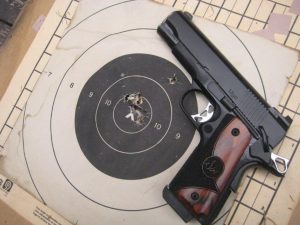
8 rounds of 45 hardball at 15 yards. The light weight DW CCO in 45ACP was as accurate as many full sized guns.
We did not bench test these two pistols except when we ran some assorted ammunition over the CED chronograph. We fired four 8-round magazines of 9mm and three 7-rounders of .45 ACP over the chrono using the head of an IDPA target 15 yards distant as an aiming point. All but one round printed nicely, more or less centered in the head box. That’s pretty good performance for a price point 1911 designed for concealed carry. (see the photo) All the other shooting we did was in the form of assorted drills and we used the 9mm to shoot a couple of IDPA matches.
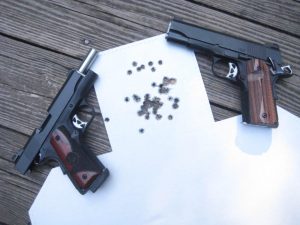
Target shot at 15 yards while chronographing both guns; they are more than accurate enough for CCW use.
It is worth noting that both of the Vigil CCOs were a joy to handle, carry and to operate at speed due to the tasteful and effective de-horning of all the edges and corners that many manufacturers leave sharp. Each pistol came with two Checkmate magazines. We also used some Wilson Combat magazines during our shooting and all fed and ejected freely from the CCOs. To date both the Vigil CCOs have experienced no malfunctions other than those mentioned above. We have great confidence in the reliability of both pistols.
We began carrying the 9mm Vigil CCO after it had digested approximately 800-900 trouble free rounds. This was mostly ball ammunition and about 100 rounds of Speer G2. Living in rural America we often carry OWB, even under light summer clothing, and for the Vigil we used a Galco Avenger cut for the Commander length slide as well as a Galco single mag pouch to accommodate a spare magazine. We also used a Galco Royal Guard for IWB carry when going to “town”. Carrying the Vigil was quite comfortable with these two rigs in combination with a Galco 1 ¾-inch SB6 Fancy Stitched Belt, which is maybe overly stout for toting a lightweight CCO, but comfortable none the less.
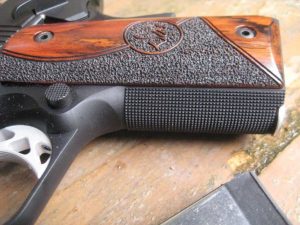
The 25LPI front strap checkering on both CCOs was about as good as machine-done checkering gets.
As they come from the factory both pistols are good to go but we could not let the 9mm (which we purchased) go long without a few modifications. We changed out the thumb safety for a Wilson Combat low thumb safety, replaced the front sight with a Gold bead model from Ed Brown and replaced the stocks with a pair from Craig Spegel made from ebony and double diamond checkered. If the 45ACP CCO sticks around it will probably get a similar treatment.
Prior to the advent of CCO configured 1911s (and the arrival of the Glock 19), the alloy framed Commander was, in many circles, considered the mark of the knowledgeable professional. For many 1911 aficionados, the CCO 1911 has now superseded the Commander in this role. The only thing one gives up over full sized guns is a one round reduction in capacity in some calibers.
These Dan Wesson Vigil CCOs have, as Jeff Cooper opined, “everything you need and nothing you don’t” in an everyday defensive sidearm. Priced at a bit more than the most basic 1911s on the market at about $900-$1,300 and quite a bit below those from the boutique and custom builders, the two CCOs we have been shooting represent a couple of the best bargains out there in the 1911 market place. Take a look at the Dan Wesson 1911 line when shopping for your next pistol.



